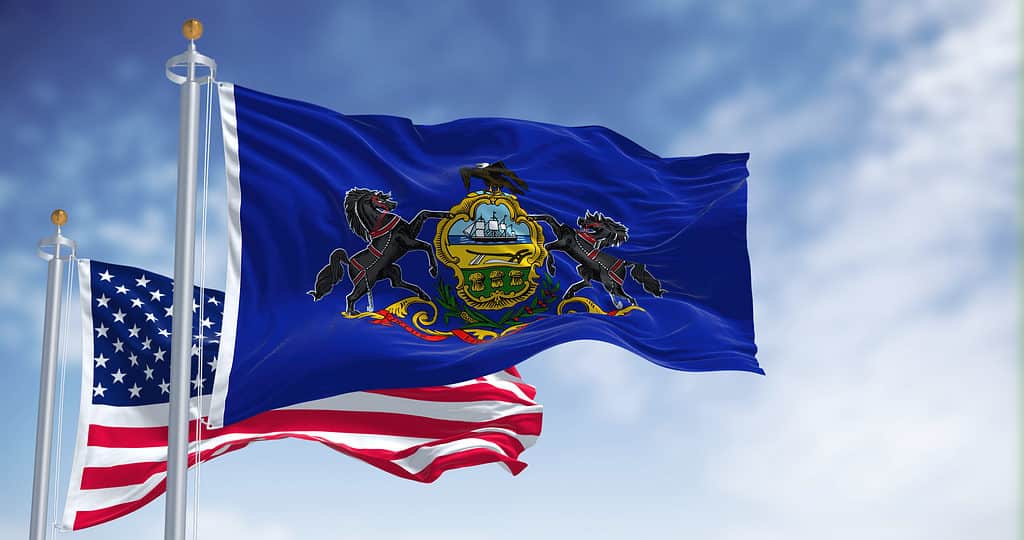Pennsylvania, officially known as the Commonwealth of Pennsylvania, is located in the northeast of the United States, in the Mid-Atlantic region. The state is bordered by Maryland, Delaware, and West Virginia in the south and New York in the north and northeast. The Delaware River forms sections of its eastern border with New York and New Jersey.
Pennsylvania boasts an area of 119,279 km² (46,054 square miles), making it the 33rd largest state in the US. And in 2021, it was estimated that 12.9 million people lived in the state, making Pennsylvania the 6th most populous state in the United States.
Popularly known as the Keystone State, this state’s capital city is Harrisburg, with Philadephia taking the crown as the largest city and Greater Philadephia as the largest urban area. Other significant cities in Pennsylvania are Allentown, Pittsburgh, and Erie.
Another feature of the state that you can’t overlook is its flag, and that’s because of the flag’s history, meaning, and symbolism. Find out more below!
Founding of Pennsylvania
A land was given to William Penn by King Charles II to pay back a huge debt incurred when Penn’s late father, Admiral William Pen, lent the king some money before he passed away. This land was named Pennsylvania by the king in honor of the elder Penn, which meant Penn’s Woodlands.
King Charles signed Pennsylvania’s Charter on the 4th of March, 1681, and the charter was officially proclaimed on the 2nd of April.
Once given this land, William Penn requested to build a shelter to protect his fellow members of the Society of Friends, also known as the Quakers. This was after Penn converted and became a religious adherent to this persecuted religion. The Quakers opposed the war, refused hierarchy, rituals, and creeds, and were more liberal and progressive with a huge interest in capitalism. These ideologies finally became a significant influence in Pennsylvania’s history.
Pennsylvania’s capital at that time, Philadephia, became the location of the first and second Continental Congresses in 1774 and 1775 with 13 colonies in attendance. The 1775 congress held at the Pennsylvania State House finally birthed the Declaration of Independence, which led to the American Revolution.
After this war, Pennsylvania, alongside other states like Delaware, ratified the 1787 US constitution. It was the second state to sign the constitution, although it tried to be the first signee to secure the National Government’s seat in Pennsylvania. This state was also the site of the Battle of Gettysburg in the American Civil War between 1861 and 1865. In this battle, Confederate General Robert E. Lee was defeated by Union General George Meade, stopping the Confederacy’s northern invasion.
Characteristics of Pennsylvania

The Pennsylvania state flag waving along with the national flag of the United States of America.
©iStock.com/rarrarorro
Pennsylvania has a few nicknames, some of which are the Keystone State, Quaker State, State of Independence, and Coal State, among others. Furthermore, the state is home to some historical items that played major roles in America’s revolutionary history, such as the Liberty Bell and the Independence Hall. This is a highlight for tourists interested in learning more about the historical state.
Interestingly, the Quaker State has birthed several famous personalities, including painter Mary Cassatt and inventors Benjamin Franklin and Robert Fulton, to mention a few.
Most importantly, Pennsylvania is well known for its agricultural and industrial prowess. It’s one of the USA’s most important centers for steel, coal, and railroads. The state is also a hot spot for mushroom production, producing more than 60% of the nation’s white mushrooms.
On top of all that, Pennsylvania is also the country’s largest food producer, housing about 2,300 food companies specializing in cocoa and chocolate products, pretzels, potato chips, vegetable products, and canned fruit. This is why the state is popularly called the “Snack Food Capital of the World.”
History and Symbolism of the Flag of Pennsylvania

The eagle on Pennsylvania’s coat of arms symbolizes the state’s loyalty to the United States, as well as strength and sovereignty.
©iStock.com/Oleksii Liskonih
While the coat of arms has existed since 1778, Pennsylvania’s flag was approved with the state coat of arms in 1799. Many Pennsylvania regiments carried flags similar to the US flags during the Civil War, but Pennsylvania’s coat of arms was used instead of the field of stars.
However, it wasn’t until the 13th of June 1907 that the present flag design was signed into law. Still, this design isn’t so different from previous ones. The only significant change is the size and color so it could fit into the specifications laid down for all state flags in the United States.
The flag of Pennsylvania is blue and is similar to other state flags in the United States because it bears the state’s coat of arms. The coat of arms was the Penn family’s symbol and consisted of a shield between two horses with a bald eagle on top. It also features a plow, an olive branch with a cornstalk underneath the shield, and three golden sheaves of wheat.
While blue is the flag’s primary color (the field), the coat of arms bears different colors, such as yellow, white, red, and black. And the coat of arms isn’t printed on Pennsylvania’s state flag; rather, it’s embroidered.
The following is what each item on the coat of arms symbolizes:
- American Eagle: Pennsylvania’s loyalty to the United States, as well as strength and sovereignty
- Two Black Horses: Diligence
- Ship: State commerce
- Wheat Sheaves: Fertile fields
- Plow: Pennsylvania’s rich natural resources and its agriculture
- Olive Branch: Peace
- Cornstalk: Prosperity
Finally, the flag bears the state’s motto, “Virtue, Liberty, and Independence.” You can see this flag displayed across all state buildings and any public construction accounted for in the law within the Commonwealth of Pennsylvania.
Up Next:
- Animals in Pennsylvania
- The 10 Countries With Stars On Their Flags, and Their Meaning
- Discover the Highest Points in Pennsylvania
- The ‘Join, or Die’ Snake Flag’s Surprising History, Meaning, and More
- Every Flag In The World: Photos, History, and More
The photo featured at the top of this post is © iStock.com/bndart
Sources
- , Available here: https://worldpopulationreview.com/states/pennsylvania/flag
- Marjorie McAtee, Available here: https://www.unitedstatesnow.org/what-is-the-history-of-the-state-flag-of-pennsylvania.htm
- , Available here: https://flagpolesetc.com/blog/pennsylvania-state-flag-history
- , Available here: https://statesymbolsusa.org/symbol-or-officially-designated-item/pennsylvania/state-coat-arms/pennsylvania-coat-arms
- , Available here: https://www.history.com/.amp/topics/us-states/pennsylvania
Thank you for reading! Have some feedback for us? Contact the AZ Animals editorial team.







